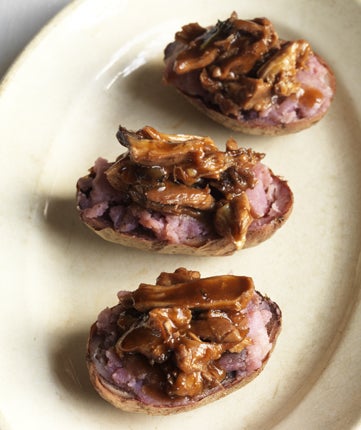Highland Burgundys are purple-fleshed heritage potatoes that we often buy from Lucy Carroll up in Northumberland (heritage-potatoes.co.uk). You could use any game bird for this, but pheasants are pretty cheap at this time of year and slow-cooking them works really well.
You could serve this as a little snack with small potatoes, or as a more substantial course if you're using larger potatoes. There are some other varieties of purple-fleshed potatoes, like salad blue earlies and Shetland blacks. Once you have removed the pheasant meat from the bone, you can also make a stock in the same way that you make a chicken stock.
4 large Highland Burgundy potatoes
50-70g butter
For the pheasant ragout
1tbsp flour
A pheasant with all of the meat taken off the bone, cut into rough 1cm pieces
Vegetable or corn oil for frying
A couple of good knobs of butter
1 medium onion, peeled, halved and finely chopped
4 cloves of garlic, peeled and crushed
1tsp thyme leaves
tbsp tomato purée
1 glass of red wine
1ltr of chicken or pheasant stock
Salt and freshly ground black pepper
Preheat the oven to 180C/gas mark 5. First, make the ragout. Season and dust the pieces of pheasant with half of the flour. Heat the vegetable oil in a frying pan and brown the pieces of pheasant on a high heat for about 4-5 minutes, then add the butter, onions, garlic and thyme and continue cooking on a high heat for a few minutes, stirring regularly, until the onions are beginning to colour.
Add the rest of the flour and tomato purée and stir well for a minute or so on the heat. Gradually add the wine and stock, bring to the boil, season and transfer to a thick-bottomed saucepan and simmer for about an hour or so, until the pheasant is tender and just falling apart.
Meanwhile place the potatoes on a tray and bake for about 45 minutes to an hour, depending on their size, until soft.
To serve, halve the potatoes and scoop them out into a bowl, mash up with the butter with a fork and season, then spoon back into the skins.
Return to the oven for about 10 minutes, make an indentation with the back of a spoon and spoon the ragout on top.

Join our commenting forum
Join thought-provoking conversations, follow other Independent readers and see their replies
Comments